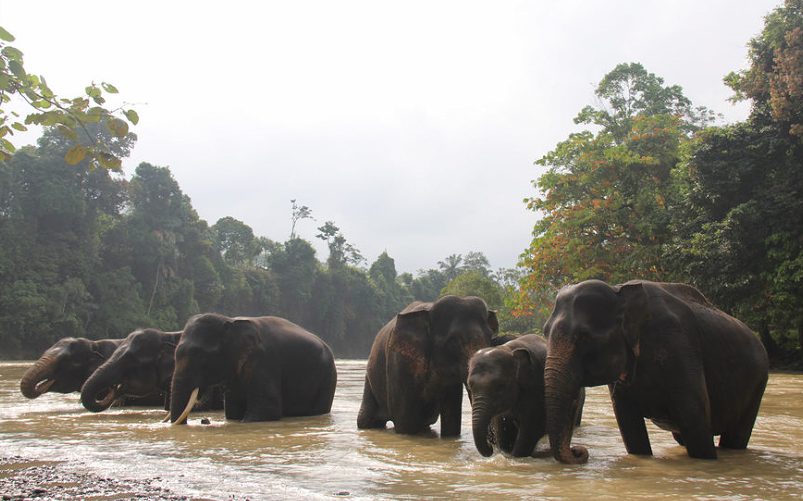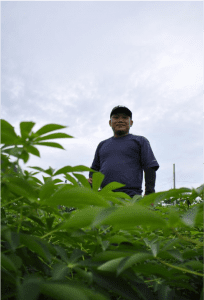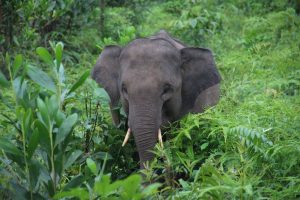Elephants in Indonesia and Their Future

-
Date:
15 Sep 2021 -
Author:
KEHATI

Deputy Head of Forest Animal Networking Association
Written by:
Deputy Head of Forest Animal Networking Association
Dr Wishnu Sukmantoro
Elephants are native species in the archipelago (Indonesia). During ancient times, at least 6 elephant genus or sub-genus lived in Indonesia since 11 million years ago (Eocene period), especially from fossil records found in Sangiran, Flores Island, Sulawesi Island, and Kalimantan. Currently, almost all elephant species in Indonesia are extinct, and only leaving two living elephant sub-types, namely Sumatran Elephant (Elephas maximus sumatranus) and Borneo Elephant (Elephas maximus borneensis).
In its history, elephants have become very important animals, mainly within Asia, as respected animals, including since the ancestral religion phase until today. For example, Ganesha, or known as Bhatara Gana, is a symbol that destroys all obstacles and bestows intelligence and prosperity. Also, elephants were known as transportation and hauling animals, even war vehicles. Elephants’ interaction and domestication has been recognized by the people across the archipelago at the time since the BC era, for example with the finding of Pasemah site in Van der Hoop’s note in 1932, where the site contains an egg-round statue sculpted into an elephant shape, flanked by a soldier on each side. So, this stone-lith, which was estimated to be made 2500 years ago, is a form of elephant domestication at that time[1],[2].
Until this time, the reverence tradition is still intact, especially in religious rituals. Symbols of institutions, including universities, and the title ‘datuk’ by the Sumatran and Kalimantan people are intended as tributes to elephants. However, the use of elephant parts is still traditionally implemented, such as the use of their ivory as dowry in Flores, or is known as belis tradition intended to increase the reputation of the family. The use of ivory for various needs, especially for souvenirs, are still done to this day for sculpted statue souvenirs, ivory bracelets, and smoking pipes.
After the Ganesha Operation in 1982 and 1983 at Sugihan, Ogan Kemering Ilir, South Sumatra, elephant training was developed through elephant management (tata liman), elephant training (bina liman), and elephant empowerment (guna liman), which ended up moving some elephants away because of conflicts with migrant people, training and managing them into trained elephants or domesticated elephants[3]. The concept of tata liman, bina liman and guna liman became one of the bases in managing domesticated elephants, which were moved due to conflicts with humans, to become domesticated elephants across Sumatra. Several safari gardens are zoos also used Sumatran elephants for tourism.
The Ganesha Operation, was intended to abolish the conflict between elephants – humans among existing migrant people. This was one of the beginnings of the community finding out conflicts between elephants and humans and the main problem of land conversion. During this era, we realized that there were conversions from natural forests into community lands and forest areas were cleared to become cultivation areas or non-natural forests.
Elephants, Land Conversion, and Rising Ecological Footprint
Land conversion is the main problem in elephant conservation in Indonesia. In Sumatra, in 1990, the total natural forest area was 21.3 million ha (48.2% within Sumatra Island). However, in 2014, there were only 10.8 million ha forest left, or during these 22 years, 10 million ha of tropical rainforest were converted with a deforestation ratio of 2.1% or 507,407 ha per year. As many as 81 – 82% deforestation occurs in lowland forests. From this total area, 82% of the converted land was located at the lowlands (non-peat), which were the most important habitat for elephants[4].

Source: Wishnu Sukmantoro
Land conversion is the consequence of the state’s needs to increase its revenue and the people’s economy. This is done to anticipate the rising number of population in Sumatra Island and increasing needs for food and energy. According to the official numbers from the Center Bureau of Statistics, the population of Sumatra is the second highest in Indonesia, with 46,136,521 people or 19.4% of Indonesia’s total population in 2010. With a growth rate of 2.1% per year, based on the growth level per province in Sumatra in 2010 (BPS 2012), the population of Sumatra was predicted at the time to become 59.34 million people in 2020.
In fact, the real numbers are not too far off, namely 58.56 million people (21.68%). The Economic Intelligent Unit (EIU) at Dupont Forum Media in Singapore ranks Indonesia as the fifth country in Southeast Asia against the food security index (65th globally in 2020[5]). This rank is below Malaysia, Thailand, Vietnam and Philippines. Therefore, the Government of Indonesia is currently trying to improve food security through various means, including reducing food import and using the bonus of young and productive population growth, which is considered a demographic bonus until 2020.
With low food security index in Indonesia, the Indonesian Government is trying to accelerate the preparations and implement food security improvements. This affects many areas in Indonesia, increasing land productivity and expanding land conversion. Even though the Covid-19 pandemic has been spreading in the last two years until 2021, the government is still implementing its food security program. Hence, at the end of 2020, Indonesia’s food security status was at a moderate level. The Global Hunger Index (GHI) 2020 stated that Indonesia has a score of 19.1, after previously ranked at a serious level, scoring 20.1 in 2019[6].
This implication is the manifestation of policies that support food self-sustainability and increased land productivity, followed by land conversion. In Sumatra, food security is focused at North Sumatra and South Sumatra, targeting cluster-based large scale agricultural businesses, multi-commodities (food, horticulture, livestock, and plantation), mechanization, modernization of agriculture and digitalization system, corporating farmers, and downstreaming agricultural production. In North Kalimantan where Borneo Elephant population is recorded, food estate is focused at Kayan Delta, far from the Borneo Elephant population pockets.
From the lesson learned of Merauke Integrated Food and Energy Estate (MIFEE), this project will require 1.28 million ha land, where 90% of the area are taken from opening natural forest lands. In this context, MIFEE can be at odds with the government’s commitment to reduce emission, enshrined in the deforestation moratorium[7]. In South Sumatra, which is home to elephant population, the food estate is concentrated at Ogan Komering Ulu and Ogan Komering Ilir. Several subdistricts have impacted the elephant – human conflict in community field areas, namely Air Sugihan Subdistrict and Sungai Menang Subdistrict. These areas are included in the 59,118 ha of field printed plan program [8]. In these areas, conflicts between elephants – humans resulting from rice field agriculture continues to occur every year[9]. Food estate can have another impact besides opening new lands, especially peatlands, namely increasing potential for elephant – human conflicts.
The Global Footprint Network Analysis, which was quoted in the Washington Post on May 4, 2017, recorded that many countries experienced a deficit of ecological footprint, which was linked to biocapacity. In 2013, Singapore’s ecological footprint reached 6.8 global hectare per capita (gha), while the biocapacity of the country was only 0.1 gha. Singapore’s ecological deficit increased 12.7 times. Indonesia experienced an ecological deficit of 18 percent, where its ecological footprint was recorded at 1.4 gha, with a biocapacity of only 1.2 gha. Despite way better compared to Singapore, one of the land uses in Indonesia for various needs still exceeded its biocapacity[10].
Population and The Threats
Land conversion causes the living space of both elephants and humans to overlap and leads to conflicts between them. Other impacts include increasing poaching activity due to easy access to elephant herds, and diseases and pollution at the elephants’ habitat. In Sumatra, conflicts between elephants and humans are predicted to have existed in the 18th century, even before that. This relates to massive land opening for plantations in Sumatra during the colonial era.
An orientalist, British pioneer William Marsden, who visited Sumatra at the 19th century, also gave his own notes on the existence of elephants. During that time, elephants had already presented a large threat for people’s plantations, because they destroyed plantations that they stepped on[11]. According to records in Sumatra during 1984 – 1996, an elephant-human conflict occurred, where 16 people died and 9 wounded resulting from elephant-human conflict in Way Kambas, Lampung[12]. Since 2000s, information on elephant-human conflict has expanded, starting from Aceh, North Sumatra, Riau, Jambi, South Sumatra, Bengkulu and Lampung.
In Riau, the greatest elephant-human conflicts are spread across 9 elephant pockets, namely Mahato, Koto Tengah, Balai Raja, Giam Siak Kecil, Tesso Nilo Utara, Tesso Nilo Tenggara, Petapahan, Serangge and Pemayungan,[13]particularly in forest areas licensed for industrial plantation forest, plantation, and other use areas (APL), even though in the end they spread to conservation areas. In 2000s, elephant-human conflicts in Aceh increased until today, especially in Aceh Tengah, Bener Meriah, Aceh Jaya and Aceh Timur.
These conflict threats are followed with poaching to obtain their ivory by poisoning or shooting them. The ivory hunt is concentrated in Aceh, Riau, Jambi, South Sumatra, Lampung and Kalimantan, particularly the elephant population in Sabah. The latest information is that a week ago, one male elephant died in East Aceh (in one palm oil plantation Business Use Right from the forest area released by the government) due to ivory poaching motive using food poisoning.
The Sumatran Elephant population in Sumatra Island has been decreasing significantly. During 1984 – 1985, in a short survey for elephant researchers, including Indonesians, they estimated that the population of Sumatran and Borneo Elephants in Indonesia at the time was 2,400 – 4,800 elephants[14]. Then, in 2007, the national elephant conservation strategic document re-estimated the elephant population in Indonesia, which was 2,400 – 2,800 elephants. After that, in 2014, on the Indonesian Elephant Conservation Forum (FKGI) workshop, elephant activists recounted the elephant population estimation, and it was estimated that there were only 1,724 elephants left. In the updated elephant conservation strategy and action plan in Indonesia yet to be released by the Ministry of Environment and Forestry, the estimated population went down again to less than 1,700 elephants in the estimation up to 2020.
Innovation and The Future
In the last 20 years, elephant conservation in Indonesia has produced many efforts carried out by a myriad of stakeholders. The Indonesian Government has regulated this conservation into a protection status. Conservation efforts at the site level by way of in-situ and ex-situ are supported by various conservation organizations, donor agencies, a number of international, national, and local environmental NGOs, as well as civil society organizations through conservation actions on the field. Universities or research organizations focused on the research aspect and community group elements as well as various companies have also contributed in providing support and direct actions on the field.
In fact, initiatives, efforts and methods developed by various organizations are unable to anticipate the decrease of elephant population, especially in the wild. The problem is integrating innovative strategies and improvements from the elephant conservation management side with the need for land conversion and funding for these conservation actions. Government policy regarding food security, which then drives some of the forest areas to be included in social forestry, especially in the elephants’ exploration territories, has also become a note as a policy gap working against elephant conservation in Indonesia.
Fortunately, in 2019, various organizations, mainly the Government of Indonesia, Indonesian Elephant Conservation Forum (FKGI), and supported by donor agencies such as TFCA (Tropical Forest Conservation Act), promoted the basic protection concept at the site level in the Urgent Action Plan (RTM) on protecting elephants in the wild. The case study done was in Sumatra, which had the greatest population decrease impact. For Borneo Elephants, FKGI and local organizations were directed more to establish a collaborative governance between local governments, stakeholders, and communities in reducing conflicts, building a participative elephant spatial pattern, and ensuring the preservation of Borneo Elephant population. This RTM served as a reflection for elephant activists and the basic actions and principles that can be implemented in a short term, aiming to at the very least preserving the elephant population in the wild. This action aimed to stop the threats against Sumatran Elephants, particularly from conflicts and poaching. On the field, the implementation of this RTM was intensively monitoring the elephant population in the wild and monitoring the threats against it, reducing the rate of elephant-human conflicts, anticipating poaching, and carrying out urgent actions to save a critical population.
August 12, 2021, is the 10th anniversary of the World Elephant Day, which can be used to reflect on conservation efforts in the future. This will surely need plenty of innovations, technologies, and philosophies. This article notes four important issues regarding innovations going forward, first is to integrate the relationship between elephants and humans into a more positive interaction, or what is called the elephant-human coexistence. Second, to align the lives of elephants and their habitat in the latest condition that is more adaptive to all landscapes, including their relationship with humans. Third is to align our mutual goals and vision on elephant governance – ex situ to support the in-situ population. Fourth is to prepare the habitats, including new ones, with an orientation of not having any disturbance in the next 100 years.
This coexistence aspect, although considered a utopia, becomes a strategic one. In reality, this does happen within several elements of the community with inherently high conflicts, where in the end the community accepts the consequence of the elephants’ existence. This concept is then developed into a spatial pattern development to separate the concentration of elephant and human activities and a strategy to arrange plantation types that are relatively less vulnerable to elephant disruption. The issue of connectivity and elephant corridor as an adaptive form of management in the reality of land use aspect includes managing elephant habitats within the industrial plantation forest concession, agricultural lands, and complex plantations as well as residential areas. This can accommodate the government’s policy in developing food security, including the social forestry strategy and forest concession governance. In the coexistence aspect, the Indonesian Government and elephant activist groups joined in FKGI have established their mutual vision for elephant – human coexistence for the next 10 years, until 2030. From this vision, lessons learned and activity results that are successful in establishing coexistence values can serve as references or benchmarks for stakeholders, from which they are expected to provide a more positive impact for elephants and communities.
[1] https://id.wikipedia.org/wiki/Megalit_Besemah
[2] Kompas.com.2009. In Pasemah, Elephant Stone “Curse” on The Bitter Tongue (Si Pahit Lidah). https://tekno.kompas.com/read/2009 /03/10/13182222/~Sains~Arkeologi?page=all.
[3] Kumparan. 2019. Berdamai di Rimba Gajah di rimba Sumatera. https://kumparan.com/kumparannews/berdamai-dengan-gajah-di-rimba-sumatera-1rFPT5XL2Ow
[4] Suhandri, Nur Anam, Sukmantoro W, Suhendra D, Charles J. 2014. 2014 – 2018 WWF Indonesia Sumatra Strategic Plan. WWF Indonesia
[5] https://foodsecurityindex.eiu.com/Country/Details#Indonesia
[6] Tempo.co. 2021.
[7] Rum IA, Komarfuzaman.2020. Konversi lahan hutan: Jawaban bijak untuk ketahanan pangan?. http://ceds.fe.unpad.ac.id/publications/analisis-ceds/325-alih-fungsi-lahan-hutan-jawaban-yang-bijak-untuk-ketahanan-pangan.html
[8] Wulandari D. 2021. OKI Siapkan 59.118 Hektare Lahan Sawah untuk Food Estate. https://sumatra.bisnis.com/ read/20210602/534/1400616/oki-siapkan-59118-hektare-lahan-sawah-untuk-food-estate.
[9] Rianti A, Garsetiasih R. 2017. Persepsi masyarakat terhadap gangguan Gajah Sumatera (Elephas maximus sumatranus) di Kabupaten Komering Ilir. Jurnal Penelitian SOsial dan Ekonomi Kehutanan 14(2):83-99.
[10] Wibawa SW. 2017. Peringkat Kekayaan Ekologis Dunia Dirilis, di Mana Indonesia?https://sains.kompas.com/read/2017/ 05/08/17370001/peringkat.kekayaan.ekologis.dunia.dirilis.di.mana.indonesia
[11] Sjafari I. 2015. Gajah dan manusia dalam sejarah: Bukan hanya meninggalkangading. https://www.kompasiana.com/jurnalgemini/gajah-dan-manusia-dalam-sejarah-bukan-hanya-meninggalkan-gading_55c9aeb35197739205988bda
[12] Nyhus JP, Sumianto, Tilson R. 2000. Crop-raiding elephants and conservation implications at Way Kambas National Park, Sumatra, Indonesia. Faculty Scholarship 47.
[13] Desai AA, Syamsuardi. 2009. Elephant status in Riau Province, Indonesia. WWFIndonesia technical report.
[14] Sukumar R. & C. Santiapillai. 1993. Asian elephant in Sumatra Population and Habitat Viability Analysis. Gajah 11: 60 – 63.
